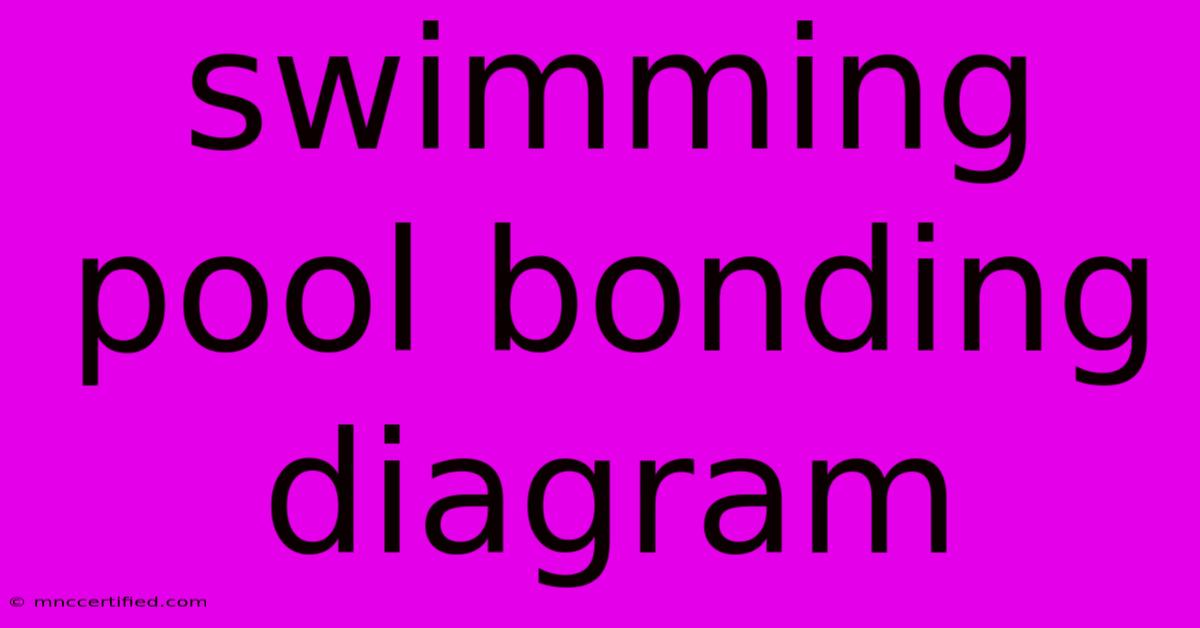Swimming Pool Bonding Diagram

Table of Contents
Swimming Pool Bonding Diagram: A Comprehensive Guide to Safety and Compliance
Swimming pool safety is paramount. A crucial element often overlooked is proper electrical bonding. This article provides a comprehensive guide to understanding swimming pool bonding diagrams, their importance, and how to ensure your pool complies with all relevant safety regulations. We'll delve into the intricacies of bonding diagrams, explaining their components and illustrating best practices for installation and maintenance.
Understanding the Importance of Swimming Pool Bonding
Electrical bonding in a swimming pool environment is a critical safety measure designed to prevent electrical shocks. It works by creating a low-resistance path for fault currents, effectively grounding any potential electrical hazards. Without proper bonding, stray voltage from faulty equipment or submerged metallic objects can create a lethal risk for swimmers. A well-executed bonding system minimizes this risk, protecting both swimmers and pool equipment.
This is where a clear and accurate swimming pool bonding diagram becomes essential. This diagram acts as a blueprint, outlining the interconnection of all metallic components within the pool's environment. It ensures that electricians and inspectors can easily understand the system's layout, confirm its integrity, and verify compliance with local electrical codes.
Key Components of a Swimming Pool Bonding Diagram
A comprehensive swimming pool bonding diagram will typically include the following elements:
1. Metallic Components:
- Pool Shell: This is usually the primary bonding point, and the diagram will clearly indicate its connection to the bonding grid.
- Pool Equipment: All metallic parts of the pool equipment, such as pumps, filters, heaters, and lights, must be bonded. The diagram should show how each piece is connected.
- Plumbing: Metallic pipes and fittings connected to the pool should be included in the bonding system and depicted in the diagram.
- Enclosures: Any metallic enclosures housing electrical components near the pool (e.g., pump motors, control panels) need to be bonded. The diagram needs to show their connection points.
- Surrounding Metal Objects: This can include fences, railings, and other metallic structures within a certain radius of the pool. The diagram will show how these elements are connected to the bonding grid to ensure a complete low-resistance path.
2. Bonding Wires and Conductors:
The diagram will specify the size and type of bonding wires used to connect all metallic components. This information is crucial for ensuring sufficient conductivity and preventing voltage buildup. Copper bonding wires are commonly used due to their high conductivity.
3. Bonding Lugs and Connectors:
These are essential components used to create secure and corrosion-resistant connections within the bonding system. The diagram will clearly show the placement and type of lugs and connectors. Properly installed and maintained connectors are vital for the system's longevity and effectiveness.
4. Grounding Electrode System:
This system serves as the ultimate ground point for the entire bonding network. The diagram will show how the bonding grid is connected to the grounding electrode, usually a ground rod driven into the earth. This ensures a safe and reliable path for fault currents to dissipate safely into the earth.
Interpreting a Swimming Pool Bonding Diagram
Understanding a swimming pool bonding diagram requires attention to detail. Look for clear labeling of all components and their connection points. The diagram should be easy to follow and clearly identify the pathways of the bonding conductors. Any ambiguity or lack of information could indicate a potential safety hazard.
Ensuring Compliance and Safety
Regular inspection and maintenance of your pool's bonding system are crucial to ensuring its effectiveness and your safety. Any corrosion, damaged wiring, or loose connections should be addressed promptly by a qualified electrician. A well-maintained system, coupled with a clear and accurate bonding diagram, significantly reduces the risk of electrical shocks and promotes a safe swimming environment.
Off-Page SEO Considerations
To further improve the ranking of this article, consider implementing the following off-page SEO strategies:
- Backlinks: Reach out to relevant websites and blogs in the pool industry and request backlinks to your article.
- Social Media Promotion: Share the article on social media platforms to increase visibility and drive traffic.
- Local SEO: If targeting a specific geographic area, optimize your article for local keywords and list your business on relevant online directories.
By following these guidelines and regularly updating your content, you will create a valuable resource for pool owners and professionals, helping you achieve higher search engine rankings and establish yourself as an authority in the field of swimming pool safety. Remember, always consult with a qualified electrician for all electrical work related to your swimming pool.

Thank you for visiting our website wich cover about Swimming Pool Bonding Diagram. We hope the information provided has been useful to you. Feel free to contact us if you have any questions or need further assistance. See you next time and dont miss to bookmark.
Featured Posts
-
Vanderpump Rules Cast On New Seasons Additions
Nov 28, 2024
-
Spotify Wrapped 2024 Release Date And Viewing Guide
Nov 28, 2024
-
Criminal Inquiry Closes Groucho Club
Nov 28, 2024
-
Bonded Title For Atv In Texas
Nov 28, 2024
-
Investigation Into Referee David Cootes Comments
Nov 28, 2024